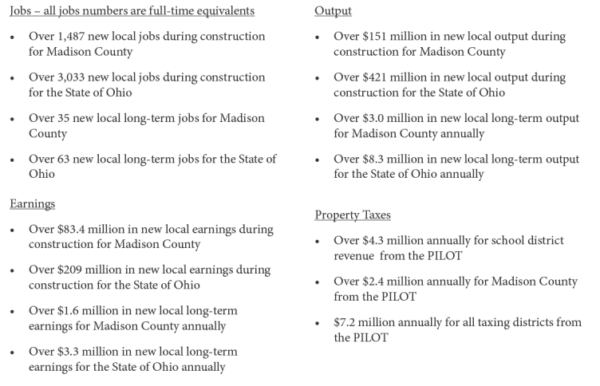The Ohio Power Siting Board is opening a public hearing for comment on the approval of what would be the largest solar facility in the nation, 800 MW, overtaking the 690 MW Gemini Solar project in Nevada. The project represents an investment of at least $1 billion, said developer Savion.
Tax revenues for Ohio are estimated to range between $242 million and $504 million over the 30 to 35 year life of the solar facility. Building the project would result in the creation of over 3,000 construction jobs. A full economic analysis for public record can be found here.
A record of public comments and related documents under review by the siting board can be found here. Over 200 comments have been submitted. A public hearing was scheduled for 5 p.m. on April 11 at Jonathan Alder High School in Plain City, Ohio.
“As a resident of Plain City I am always thrilled with new opportunities for our county to grow. Approving the Oak Run Solar project will bring a lot of potential for growth through the millions of dollars it will bring the county’s tax base along with investments in education. I enthusiastically support Oak Run,” said resident David Quinones in a public comment.
The massive solar project would be installed on 6,000 acres of land in rural Madison County, Ohio. If approved, construction would begin in 2023, with commercial operations coming online in phases starting in 2025.
A comprehensive study of the economic effects on the local and state economy was submitted to the siting board as part of the publicly available review process. Nearly 1,500 Madison County construction jobs would be created, and over 3,000 for the state. Over 63 permanent operations and maintenance jobs would be supported by Oak Run.

Oak Run solar would also include 300 MW of Tesla battery energy storage, which is expected to have a 20-year lifespan. Design submissions on public record call for the installation of modules supplied by most Tier 1 solar module providers, including Canadian Solar, JA Solar, Jinko Solar, Longi, Maxeon, Titan Vertex/Trina Solar, VSun, and US-based First Solar. Trackers may include single-axis tracking from GameChange Solar, Nextracker, Array Technologies, and FTC Voyager. Sungrow was selected as inverter provider.
The report included an economic land use analysis regarding the purchase of the agricultural land for the new facility.
Using a real-options analysis, the land use value of solar purchasing far exceeds the value for agricultural use in Madison County.
The price of corn would need to rise to $21.31 per bushel or yields for corn would need to rise to 462.6 bushels per acre by the year 2056 for corn farming to generate more income for the landowner and local community than the annualized solar payment. At the time of the report, September 2022, corn was sold for $5.45 per bushel and yields were 210.1 bushels per acre.
Alternatively, the price of soybeans would need to rise to $62.55 per bushel or yields for soybeans would need to rise to 167.2 bushels per acre by the year 2056 for soybean farming to generate more income than Oak Run. At the time of this report, soybean prices were $13.10 per bushel respectively and yields were 62.2 bushels per acre.
“What a tragedy. Oak run project. 5,000 acres of corn equal 1,100,000 bushels of corn every year. Over 50% Kokomo soil, some of the best in the world. I am not against solar panels. I am against solar panels replacing GOD given soil. No amount of money is worth our soil,” said resident Tim Kronk in public comment.
Agrivoltaics, or the practice of co-locating crop production with solar energy facilities, is a practice being evaluated worldwide for mutual benefits to both the solar equipment and the yield of crops.
As much as $300 million in funding would be generated for local public schools in direct result of the project.
“I believe projects like Oak Run will be able to provide more opportunities for long-term investments that will make sure our county has the resources to ensure our school systems are well funded and there are job opportunities,” said resident Gabriel Torres in public comment.
This content is protected by copyright and may not be reused. If you want to cooperate with us and would like to reuse some of our content, please contact: editors@pv-magazine.com.









Is that 800 MW number AC or DC capacity? Same goes for Gemini’s 690 MW.
The corn being grown on this soil accounts for only a small percentage of similar acres being grown to make ethanol for gasohol. Soon farmers will lose that revenue as cars become electrified. This project will keep them profiting from the transportation sector into the future. The soil will be unharmed and returned to agricultural use when the panels are retired.